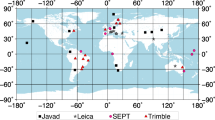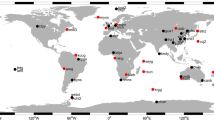Abstract
Pseudorange bias handling is essential in satellite positioning, navigation and timing (PNT) services and ionospheric modeling. Differential code bias (DCB) is commonly utilized and parameterized as the differential form of the pseudorange bias. To overcome the challenges of the inflexible and inconvenient extendable DCB calibration for the multi-frequency observations with multiple signal modulations, the pseudorange observable-specific signal bias (OSB) is used alternatively as the observation-specific individual bias representation. The study estimates the pseudorange OSBs of all the observation channels with two rigorous and modified multi-frequency approaches: multi-frequency modified carrier-to-code leveling (MFMCCL) and multi-frequency modified precise point positioning (MFMPPP) approaches. Both two approaches extract the slant ionospheric observables by considering the time-variant characteristic of the receiver pseudorange bias, after that estimating the pseudorange OSBs with certain reliability. After solving the various linear combinations of the pseudorange OSBs by two approaches, including the slant ionospheric observables and satellite-plus-receiver (SPR) pseudorange biases, all possible multi-frequency pseudorange OSBs are estimated simultaneously. Both two approaches are discussed for the GNSS observations with the code division multiple access (CDMA) and frequency division multiple access (FDMA) models. The two methods are validated with one-month data to estimate 31 types of pseudorange OSBs for the GPS, BDS, GLONASS and Galileo systems. Compared with the Chinese Academy of Sciences (CAS) pseudorange OSB product, the results indicated that both two proposed approaches can estimate the reliable multi-frequency multi-GNSS pseudorange OSBs with high stability and consistency.










Similar content being viewed by others
Data availability
The GNSS observation data used is provided by the MGEX network (ftp://igs.ign.fr/pub/igs/data/campaign/mgex/daily/rinex3/). The precise products are provided by the GFZ (ftp://ftp.gfz-potsdam.de/GNSS/products/mgex/).
References
Banville S, Geng J, Loyer S, Schaer S, Springer T, Strasser S (2020) On the interoperability of IGS products for precise point positioning with ambiguity resolution. J Geod 94(10):1–15
Dach R et al (2009) GNSS processing at CODE: status report. J Geodesy 83:353–365
Deng Y, Guo F, Ren X, Ma F, Zhang X (2021) Estimation and analysis of multi-GNSS observable-specific code biases. GPS Solutions 25:1–13
Ge Y, Zhou F, Sun B, Wang S, Shi B (2017) The impact of satellite time group delay and inter-frequency differential code bias corrections on multi-GNSS combined positioning. Sensors 17:602
Geng J, Wen Q, Zhang Q, Li G, Zhang K (2022) GNSS observable-specific phase biases for all-frequency PPP ambiguity resolution. J Geod 96:11. https://doi.org/10.1007/s00190-022-01602-3
Guo J, Jiang W, Chen Y, Ma X, Chen H (2022) Long-term and short-term stability characteristics of receiver inter system bias for BDS3/BDS2. Geodesy Geodyn.
Hauschild A, Montenbruck O (2016) A study on the dependency of GNSS pseudorange biases on correlator spacing. GPS Solutions 20:159–171
Huang L, Fang X, Zhang T, Wang H, Cui L, Liu, L (2022) Evaluation of surface temperature and pressure derived from MERRA-2 and ERA5 reanalysis datasets and their applications in hourly GNSS precipitable water vapor retrieval over China. Geodesy and Geodynamics.
Jiang W, Liu T, Chen H, Song C, Chen Q, Geng T (2022) Multi-frequency phase observable-specific signal bias estimation and its application in the precise point positioning with ambiguity resolution. GPS Solutions 27(1):1–12. https://doi.org/10.1007/s10291-022-01325-0
Jin S, Jin R, Li D (2016) Assessment of BeiDou differential code bias variations from multi-GNSS network observations. Ann Geophys 09927689:34
Laurichesse D, Blot A (2016) Fast PPP convergence using multi-constellation and triple-frequency ambiguity resolution. In: Proceedings of ION GNSS 2016 Institute of Navigation, Oregon, Portland, April, 403–412
Leick A, Rapoport L, Tatarnikov D (2015) GPS satellite surveying. John Wiley & Sons
Li M, Yuan Y (2021) Estimation and analysis of the observable-specific code biases estimated using multi-GNSS observations and global ionospheric maps. Remote Sens 13:3096
Li Z, Yuan Y, Li H, Ou J, Huo X (2012) Two-step method for the determination of the differential code biases of COMPASS satellites. J Geodesy 86:1059–1076
Li X, Xie W, Huang J, Ma T, Zhang X, Yuan Y (2019) Estimation and analysis of differential code biases for BDS3/BDS2 using iGMAS and MGEX observations. J Geodesy 93:419–435
Li M, Yuan Y, Zhang X, Zha J (2020a) A multi-frequency and multi-GNSS method for the retrieval of the ionospheric TEC and intraday variability of receiver DCBs. J Geodesy 94:1–14
Li X et al (2020b) The phase and code biases of Galileo and BDS-3 BOC signals: effect on ambiguity resolution and precise positioning. J Geodesy 94:1–14
Li X, Li X, Jiang Z, Xia C, Shen Z, Wu J (2022) A unified model of GNSS phase/code bias calibration for PPP ambiguity resolution with GPS, BDS, Galileo and GLONASS multi-frequency observations. GPS Solut 26:84. https://doi.org/10.1007/s10291-022-01269-5
Liu T, Zhang B (2021) Estimation of code observation-specific biases (OSBs) for the modernized multi-frequency and multi-GNSS signals: an undifferenced and uncombined approach. J Geodesy 95:1–20
Montenbruck O, Hauschild A, Steigenberger P (2014) Differential code bias estimation using multi-GNSS observations and global ionosphere maps. Navigation 61(3):191–201
Odijk D, Zhang B, Khodabandeh A, Odolinski R, Teunissen PJ (2016) On the estimability of parameters in undifferenced, uncombined GNSS network and PPP-RTK user models by means of S-system theory. J Geod 90(1):15–44
Rebeyrol E, Julien O, Macabiau C, Ries L, Delatour A, Lestarquit L (2007) Galileo civil signal modulations. GPS Solutions 11:159–171
RTCM (2016) RTCM standard 10403.3 differential GNSS (global navigation satellite systems) services-version 3 RTCM Special Committee
Schaer S, Villiger A, Arnold D, Dach R, Prange L, Jäggi A (2021) The CODE ambiguity-fixed clock and phase bias analysis products: generation, properties, and performance. J Geod 95:81. https://doi.org/10.1007/s00190-021-01521-9
Schaer S (2012) Overview of relevant GNSS biases. In: Proceedings of IGS workshop on GNSS biases. University of Bern, Switzerland, 18–19 Jan
Schaer S (2016) BIAS—Solution (Software/technique) INdependent EXchange Format for GNSS BIASes Version 1.00. In: IGS workshop on GNSS biases, Bern, Switzerland, 2016.
Sharma G (2022) Manifestation of earthquake preparation zone in the ionosphere before 2021 Sonitpur, Assam earthquake revealed by GPS-TEC data. Geodesy Geodyn 13(3):230–237
Su K, Jin S, Jiang J, Hoque M, Yuan L (2021) Ionospheric VTEC and satellite DCB estimated from single-frequency BDS observations with multi-layer mapping function. GPS Solutions 25:1–17
Su K, Jin S, Jiao G (2022) GNSS carrier phase time-variant observable-specific signal bias (OSB) handling: an absolute bias perspective in multi-frequency PPP. GPS Solut 26:71. https://doi.org/10.1007/s10291-022-01255-x
Vergados P, Komjathy A, Runge TF, Butala MD, Mannucci AJ (2016) Characterization of the impact of GLONASS observables on receiver bias estimation for ionospheric studies. Radio Sci 51:1010–1021
Villiger A, Schaer S, Dach R, Prange L, Sušnik A, Jäggi A (2019) Determination of GNSS pseudo-absolute code biases and their long-term combination. J Geodesy 93:1487–1500
Wang N, Li Z, Duan B, Hugentobler U, Wang L (2020a) GPS and GLONASS observable-specific code bias estimation: comparison of solutions from the IGS and MGEX networks. J Geodesy 94:1–15
Wang Q, Jin S, Yuan L, Hu Y, Chen J, Guo J (2020b) Estimation and analysis of BDS-3 differential code biases from MGEX observations. Remote Sensing 12:68
Wilson BD, Mannucci AJ (1993) Instrumental biases in ionospheric measurement derived from GPS data.
Yao Z, Zhang J, Lu M (2016) ACE-BOC: dual-frequency constant envelope multiplexing for satellite navigation. IEEE Trans Aerosp Electron Syst 52:466–485
Yuan Y, Ou J (2004) A generalized trigonometric series function model for determining ionospheric delay. Prog Nat Sci 14:1010–1014
Zhang B, Ou J, Yuan Y, Li Z (2012) Extraction of line-of-sight ionospheric observables from GPS data using precise point positioning. Sci China Earth Sci 55:1919–1928
Zhang B, Chen Y, Yuan Y (2019a) PPP-RTK based on undifferenced and uncombined observations: theoretical and practical aspects. J Geodesy 93:1011–1024
Zhang B, Teunissen PJ, Yuan Y, Zhang X, Li M (2019b) A modified carrier-to-code leveling method for retrieving ionospheric observables and detecting short-term temporal variability of receiver differential code biases. J Geodesy 93:19–28
Zhang X, Zhang B, Yuan Y, Zha J, Li M (2019c) A refined carrier-to-code levelling method for retrieving ionospheric measurements from dual-frequency GPS data. Meas Sci Technol 31:035010
Zhang B, Zhao C, Odolinski R, Liu T (2021) Functional model modification of precise point positioning considering the time-varying code biases of a receiver. Satellite Navigation 2:1–10
Zhang B, Teunissen P, Yuan Y, Zhang X, Li M (2018) A modified carrier-to-code leveling method for retrieving ionospheric observables and detecting short-term temporal variability of receiver differential code biases. J Geodesy 19–28
Zhou F, Dong D, Ge M, Li P, Wickert J, Schuh H (2018) Simultaneous estimation of GLONASS pseudorange inter-frequency biases in precise point positioning using undifferenced and uncombined observations. GPS Solutions 22:19
Acknowledgements
The authors would like to acknowledge the MGEX for providing the multi-GNSS observations.
Author information
Authors and Affiliations
Contributions
KS initiated the main idea of the manuscript and design the experiment. KS wrote the manuscript. GJ revised the manuscript. All authors joined discussions throughout the development.
Corresponding author
Ethics declarations
Competing interests
The authors declare no competing interests.
Additional information
Publisher's Note
Springer Nature remains neutral with regard to jurisdictional claims in published maps and institutional affiliations.
Rights and permissions
Springer Nature or its licensor (e.g. a society or other partner) holds exclusive rights to this article under a publishing agreement with the author(s) or other rightsholder(s); author self-archiving of the accepted manuscript version of this article is solely governed by the terms of such publishing agreement and applicable law.
About this article
Cite this article
Su, K., Jiao, G. Two modified multi-frequency GNSS approaches to estimate the pseudorange observable-specific signal bias for the CDMA and FDMA models. GPS Solut 27, 83 (2023). https://doi.org/10.1007/s10291-023-01417-5
Received:
Accepted:
Published:
DOI: https://doi.org/10.1007/s10291-023-01417-5




